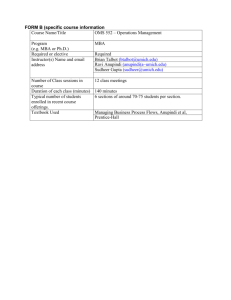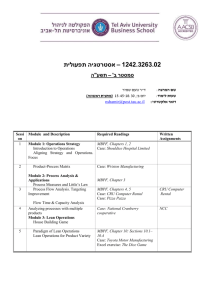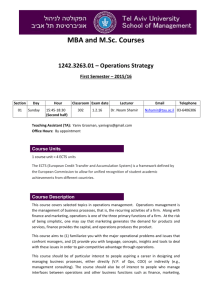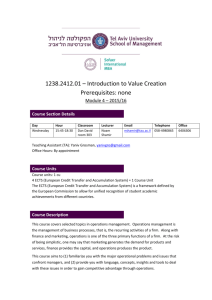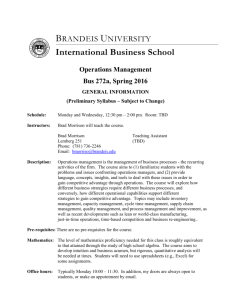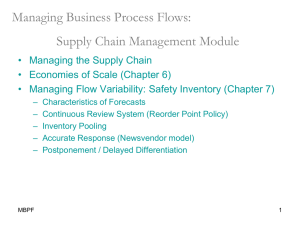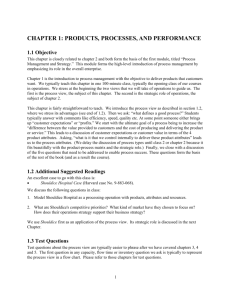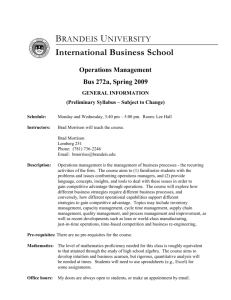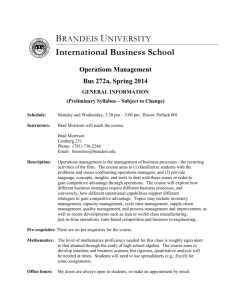Detailed Syllabus - Kellogg School of Management
advertisement
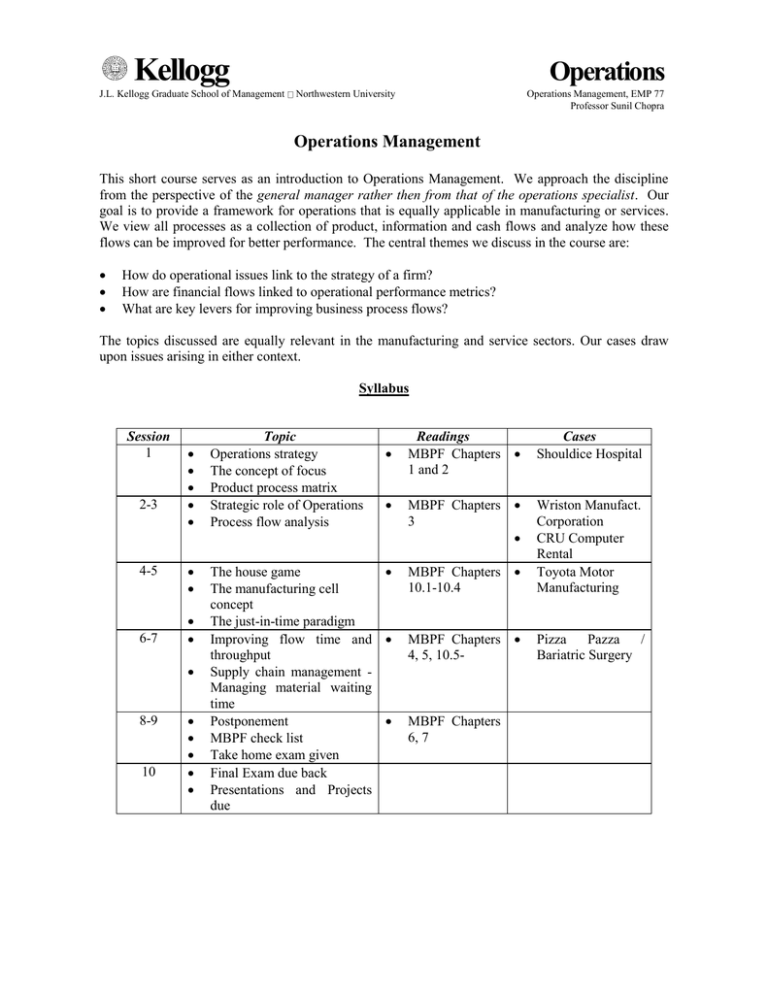
Kellogg J.L. Kellogg Graduate School of Management Operations Northwestern University Operations Management, EMP 77 Professor Sunil Chopra Operations Management This short course serves as an introduction to Operations Management. We approach the discipline from the perspective of the general manager rather then from that of the operations specialist. Our goal is to provide a framework for operations that is equally applicable in manufacturing or services. We view all processes as a collection of product, information and cash flows and analyze how these flows can be improved for better performance. The central themes we discuss in the course are: How do operational issues link to the strategy of a firm? How are financial flows linked to operational performance metrics? What are key levers for improving business process flows? The topics discussed are equally relevant in the manufacturing and service sectors. Our cases draw upon issues arising in either context. Syllabus Session 1 2-3 4-5 6-7 8-9 10 Topic Operations strategy The concept of focus Product process matrix Strategic role of Operations Process flow analysis Readings MBPF Chapters 1 and 2 Cases Shouldice Hospital MBPF Chapters 3 The house game The manufacturing cell concept The just-in-time paradigm Improving flow time and throughput Supply chain management Managing material waiting time Postponement MBPF check list Take home exam given Final Exam due back Presentations and Projects due MBPF Chapters 10.1-10.4 Wriston Manufact. Corporation CRU Computer Rental Toyota Motor Manufacturing MBPF Chapters 4, 5, 10.5- Pizza Pazza / Bariatric Surgery MBPF Chapters 6, 7 Operations Management Professor Sunil Chopra Text Managing Business Process Flows by R. Anupindi, S. Chopra, S. Deshmukh, J. A. Van Mieghem and E. Zemel. The Goal: A Process of Ongoing Improvement by E. M. Goldratt and J. Fox, North River Press, Inc. Managing Business Process Flows (referred to as MBPF) is a book developed by the Operations faculty at Kellogg. I would appreciate any suggestions for improvement that you may have. The Goal is an interesting book that reads as a novel. Nevertheless, it has over 300 pages so I encourage you to start reading now. Please read the book prior to start of classes. As you read the book, jot down the three or four main ideas that you find striking with respect of the book. You will need this list for your last assignment. Grades Grades will be computed as follows: Assignments Group Project Final Exam 20% 20% 60% Assignments, responsibilities, and the honor code: Assignments for class fall into three categories: (i) Submission, (ii) Case preparation (iii) Readings. Submissions: correspond to assignments requiring a written submission. They should be brief and concise. Please respect the page limits indicated for each assignment. All written assignments should be typed, and are due at the beginning of the session indicated. In general they are to be posted on to the discussion board. Even if you post the assignment on to the discussion board, please submit a hard copy in class. No late submissions will be accepted. All submissions for the class are to be in groups. You may sign your name on a group project only if you have personally contributed substantially to the group discussion that preceded the group submission. If you cannot attend the group meeting, or participate in the group discussion, you can still get full credit towards the assignment by submitting a report on your own. For each assignment I will select one group to make a 5-10 minute presentation at the beginning of class. The assignments list the groups that will be preparing presentations in each case. The groups making presentations can simply submit their overheads used for the presentation and do not need a report. Practice Problems: In some sections with quantitative methodology, practice problems from the book are listed. Solutions to all problems at the back of the book are available at http://www.kellogg.northwestern.edu/course/opns430/materials/MBPF-solutions.html ) Case preparation: Each week we will be discussing one or two cases. I recommend that each group set aside 30-60 minutes for case preparation. Each person should come to the discussion group having read the case once. The group can then discuss the case and some of the issues raised in the question. This way you will be well prepared for the discussion in class and get the most out of it. Readings from the book MBPF are best read either just before or soon after the lecture. 2 Operations Management Professor Sunil Chopra How to reach me I enjoy and welcome interactions outside the classroom. You can reach me at my office at 847-4918169, or through the e-mail at the address s-chopra@kellogg.northwestern.edu. My fax number is 847467-1220. The World Wide Web I have created a home page for the course that can be accessed on the world wide web. The world wide web address is http://www.kellogg.northwestern.edu/course/opns430/emp/chopra/ Accessing this web site will allow you to download all files related to the course. I will also be posting course related announcements. In the home page I will provide links to other web locations that may be of interest to the class. First assignment: See instructions for session 1. Please try to read the book “The Goal” by the start of classes. Detailed Syllabus Session 1: Objectives: Operations as an inputs-outputs transformation A strategic framework for operational decisions: What is improvement? The concept of focus The product-process matrix Assignment 1 (To be completed before session 1. No Submission) I. Reading: MBPF Chapters 1 and 2. (may be read after the lecture) II. Case preparation: Prepare the Shouldice Hospital case considering the following questions: A. Model Shouldice hospital as a processing operation with inputs, outputs and resources. B. What market segment(s) has Shouldice chosen to focus on? What are the needs of this market that Shouldice serves? How does their operations strategy and structure support their business strategy? Sessions 2&3: Objectives: Finish discussion on the strategic role of Operations The fundamentals of process flow Target improvement: Where to improve? The concepts of flow time, throughput and inventory and the relation between them Identifying performance measures to improve 3 Operations Management Professor Sunil Chopra Assignment 2 (To be completed before session 2) I. Submission: In preparation for the group meeting, identify, individually, an organization or unit that could be improved by focusing. In the group, discuss each of the examples brought forward by the group members. Select one example and describe in writing. Describe the situation as is, the steps needed for focusing, and the potential benefits and liabilities. Submit one report per group, 2 pages maximum. It is preferable that the report is posted on the discussion board. Groups A and B will prepare presentations with all other groups writing a report. II. Case preparation: Each group should prepare one or two overheads considering the following question: A. What should Richard do with the Detroit plant? Prepare supporting arguments to be presented in class. III. Case Preparation: Prepare the CRU Rental case for discussion. Consider the study questions in the case. IV. Readings: MBPF Chapter 3 (Read Sections 3.1-3.5 before class. Rest may be read after the lecture) V. Practice Problems: 3.1, 3.4, 3.8, 3.10 (For solutions to all problems go to http://www.kellogg.northwestern.edu/course/opns430/materials/MBPF-solutions.html ) Sessions 4&5 Objectives: Simulation: The house game Synchronous manufacturing and the just-in-time paradigm Assignment 3 (To be completed before session 4) I. Submission: Perform a detailed flow analysis of the financial flows in your firm. Use the previous year financial information. Pick a process and perform a detailed analysis of product flows (ideally as in the CRU case) through that process. Status quo performance in terms of various operational measures should be detailed. Submit one report per group, 2 pages maximum. Groups C and D will prepare presentations with all other groups writing a report. II. Reading: MBPF Chapter 10 until section 10.4. (may be read after the lecture) III. Prepare the Toyota Motor Company Case considering the following question: A. How does Toyota increase visibility of waste? B. What do you think is the cost of a cord pull resulting in the line being stopped for 1 minute, 2 minutes, 30 minutes, 60 minutes? C. Based on the information in the case, what do you recommend Doug Friesen do? Why? Accompanying readings (may be read at your leisure): A. Revenue cycle management at ENH IV. 4 Operations Management Professor Sunil Chopra Sessions 6&7: Objectives: Evaluating and improving process performance in terms of flow time and throughput The concepts of flow time, throughput and inventory and the relation between them Critical activities and bottleneck resources Managerial levers for increasing throughput and decreasing flow time Supply chain management Assignment 4 (To be completed before session 6) I. Submission: In preparation for the group meeting, identify, individually, a process to which the basic ideas of a cell could be applied. In the group, discuss each of the examples brought forward by the group members. Select one example and describe in writing. Describe the situation as is, the steps needed for implementing any change, and the potential benefits and liabilities. Submit one report per group, 2-3 pages maximum. Groups E and F will prepare presentations with all other groups writing a report. II. Case Preparation: Prepare the Bariatric Surgery case for discussion. Consider the study questions in the case. Read the Pizza Pazza case and solutions in preparation for the Bariatric Surgery case. III. Readings: MBPF Chapters 4, 5, 10.5 onward (Read 4.1, 4.2, 4.3.1, 4.4, 5.1, 5.2, 5.3.1, 5.5 before class. Rest may be read after the lecture) IV. Practice Problems: 4.1, 4.2, 4.4, 4.5, 5.1, 5.2, 5.4, 5.7 (For solutions to all problems go to http://www.kellogg.northwestern.edu/course/opns430/materials/MBPF-solutions.html ) Sessions 8 & 9: Objectives: Postponement Wrap up Final exam will be handed out Assignment 5 (To be completed before session 8) I. Submission: Identify an organization which is familiar to your group’s members where the issue of bottlenecks, increasing throughput and reducing flow times is of importance. Map the process, identifying bottleneck resources. Discuss how the strategies discussed in class have been used or could be used to improve operations in terms of flow time and throughput. Submit one report per group, 2 pages maximum. Groups G and H will prepare presentations with all other groups writing a report. II. Submission (to be submitted by all groups): Summarize the three or four main ideas you got from the book “The Goal”. Indicate if and how these ideas could be used in the context of the group members’ organizations. Submit one report per group, 2 pages maximum. 5 Operations Management Professor Sunil Chopra III. Readings: MBPF Chapters 6 (exclude 6.7), 7 (exclude 7.4 and 7.5) (may be read after the lecture). For Chapters 6, 7 we will focus on the concepts rather than methodology. IV. Accompanying readings (may be read at your leisure): A. Kellogg note on Postponement Session 10: Objectives: Project Presentations Projects and final exam due Final Group Project The project should be done in groups. It is due, in writing, at the beginning of our last class. A typical project may be 8-12 typed pages (double spaced), plus appendices. Three of the groups will be asked to make 20-minute presentations each. These groups need not write a detailed report. They can simply submit their presentation material. Process Improvement--a field study. This entails the following: I. II. III. IV. V. VI. VII. VIII. IX. X. Identify an organization familiar to your group and to which your group has some access. The organization should be of a modest size and relatively well defined in terms of location and size. For example: a single plant or service facility, an MIS department, a single store, a logistics organization, a ski resort, a taxi company, etc. We will refer to the organization below as your "unit". Provide a short description of your unit and its environment. Characterize the strategic role of the unit. Which customer needs is it trying to serve? Identify and prioritize a few processes in the unit with significant leverage. Significant leverage here implies that the process has a significant impact on the unit’s ability to perform its strategic role. Select one of the processes and identify what this process should be able to do well to support the strategic objectives What are the current capabilities of the process? How do they compare with the desired capabilities? How is the process currently structured? Does this structure support the desired capabilities? Improve the process: (“could be” and “should be”). In the improvements identify clearly tools and / or concepts learned in classes that have been used. What are the required modifications of infrastructure? In the modifications identify clearly tools and / or concepts learned in classes that have been used. Provide some ideas concerning implementation. 6

